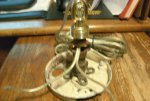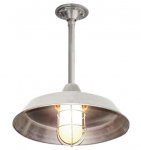You are using an out of date browser. It may not display this or other websites correctly.
You should upgrade or use an alternative browser.
You should upgrade or use an alternative browser.
What is it?
- Thread starter al
- Start date
- Status
- Not open for further replies.
jumper
Senior Member
- Location
- 3 Hr 2 Min from Winged Horses
My SWAG-an old fitting/hickey doodad called a crow's foot, I got no clue as to what it was used for.
- Location
- New Jersey
- Occupation
- Journeyman Electrician
You can screw it to the structure above a fixture and hang a 3/8" fixture stem on it.
- Location
- Placerville, CA, USA
- Occupation
- Retired PV System Designer
With room to run the wires through one of the arches in the base, which you could not do with a standard plumbing mounting flange and a nipple.You can screw it to the structure above a fixture and hang a 3/8" fixture stem on it.
mjf
Senior Member
Living in an older part of the country, I've seen a few of these over the years. Yours even has a bit of lead-based paint on it!
I don't believe that particular fitting is intended for running wires through it... at least not using single conductor wiring methods, as there doesn't appear to be any means to make connection to the underside.
IMO that is just a support fitting, assuming it is for conduit to begin with.
An example would be a conduit drop from overhead supply where the conductors terminate or branch off before getting to the floor, such as with a "T" condulet. Conduit continues to the floor where this fitting is used to attach the run to the floor for support.
IMO that is just a support fitting, assuming it is for conduit to begin with.
An example would be a conduit drop from overhead supply where the conductors terminate or branch off before getting to the floor, such as with a "T" condulet. Conduit continues to the floor where this fitting is used to attach the run to the floor for support.
junkhound
Senior Member
- Location
- Renton, WA
- Occupation
- EE, power electronics specialty
What Golddigger said.
Grandma's house (Grandpa built house in 1907, wired in 1913/14) had a few of those (probably still does, but with NM run thru them now).
Linen or cotton insulated wire was pulled thru the previous gas lighting pipes, obviously the 90 deg nipples were removed. Then you could use the old gas ceiling fixture with the addition of an Edison socket, attach the old vertical gas pipe sans nipple to the crow foot, and run your wire.
Worked for K&T run to the fixture also.
All of Grandma's ceiling fixtures had an on-off pull chain Edison socket, still had the gas jets attached too (but no gas).
Nary a wall switch in Grandma's house until I put a few in for her during the 1950's.
Grandma's house (Grandpa built house in 1907, wired in 1913/14) had a few of those (probably still does, but with NM run thru them now).
Linen or cotton insulated wire was pulled thru the previous gas lighting pipes, obviously the 90 deg nipples were removed. Then you could use the old gas ceiling fixture with the addition of an Edison socket, attach the old vertical gas pipe sans nipple to the crow foot, and run your wire.
Worked for K&T run to the fixture also.
All of Grandma's ceiling fixtures had an on-off pull chain Edison socket, still had the gas jets attached too (but no gas).
Nary a wall switch in Grandma's house until I put a few in for her during the 1950's.
- Location
- Illinois
- Occupation
- retired electrician
That would be installed in the outlet box. The four holes in the fixture hickey line up with the holes in the box and you run the screws through at least two of the holes into the structure to support the hickey and the box. There is room enough for single conductor fixture wires to enter via the notches between the feet of the hickey.I don't believe that particular fitting is intended for running wires through it... at least not using single conductor wiring methods, as there doesn't appear to be any means to make connection to the underside.
...
- Location
- New Jersey
- Occupation
- Journeyman Electrician
That would be installed in the outlet box. The four holes in the fixture hickey line up with the holes in the box and you run the screws through at least two of the holes into the structure to support the hickey and the box. There is room enough for single conductor fixture wires to enter via the notches between the feet of the hickey.
I agree typically if you had a row of fixtures one stem, with the crows foot in the box, which would contain the conductors the others would just be for support with or without a box.
We installed many of them a few weeks ago to hang track light stems off of the deck.
- Location
- Placerville, CA, USA
- Occupation
- Retired PV System Designer
Yes, except in places where a hickey meant only the C or O shaped double female fitting and this item would be called a crowfoot instead. Take a look at the range of images which match the term.Would this item be called a hickey?
So the conduit goes through the box cover?That would be installed in the outlet box. The four holes in the fixture hickey line up with the holes in the box and you run the screws through at least two of the holes into the structure to support the hickey and the box. There is room enough for single conductor fixture wires to enter via the notches between the feet of the hickey.
Where lighting fixtures and such are hung from a box using conduit as its support, I typically see the ball-type swivel covers.
PetrosA
Senior Member
- Location
- Lancaster, Pennsylvania
Crow's foot sounds right to me too, but it's been a lot of years since I've seen one. I've seen small pancakes mounted to these through the middle KO and a retaining nut, I've seen them installed inside a pancake or 4" octagon and screwed through the back (sometimes hickeys were screwed onto them), and I've seen them screwed directly to joists or porch roof rafters with fixtures hung directly from them w/out a box. I've never seen them mounted to a gas pipe - that would be a hickey, which is similar to a coupling but has slots cut in the side and may have different sized threads on each end. I also remember seeing fixture wire coming out the slots at the bottom (or top, when installed) or it came out the slots of the hickey, if used.
rt66electric
Senior Member
- Location
- Oklahoma
Stud hickey for Heavy fixtures.
Stud hickey for Heavy fixtures.
A typical modern light fixture still uses a 3/8 hollow allthread stem. similar to most Chain and pendant fixtures , the zip cord goes thru the all-thread.
the hickey stud is bolted to the j-box. There is a niffty connector(like a ridgid collar with holes on the sides for the zip cord to emerge out.) that connects the stud to the allthread. Then the beauty plate slides up and set screws in place
Ah heck with that explaination.. I can put one together w/scrap parts and take pic
put one together w/scrap parts and take pic
Stud hickey for Heavy fixtures.
A typical modern light fixture still uses a 3/8 hollow allthread stem. similar to most Chain and pendant fixtures , the zip cord goes thru the all-thread.
the hickey stud is bolted to the j-box. There is a niffty connector(like a ridgid collar with holes on the sides for the zip cord to emerge out.) that connects the stud to the allthread. Then the beauty plate slides up and set screws in place
Ah heck with that explaination.. I can
 put one together w/scrap parts and take pic
put one together w/scrap parts and take picPetrosA
Senior Member
- Location
- Lancaster, Pennsylvania
The hickey is just that final, bulged part that's threaded onto the extender which is threaded onto the crow's foot in your pic.
- Location
- Illinois
- Occupation
- retired electrician
The 3/8" fixture stem goes on to the fitting in the box and a canopy covers the box.So the conduit goes through the box cover?
Where lighting fixtures and such are hung from a box using conduit as its support, I typically see the ball-type swivel covers.
I have never seen the swivels other than in industrial occupancies.
Well I haven't done any residential work (other than my own house) in over 25 years... and even then, never saw one of those. Haven't seen 'em used in commercial either.The 3/8" fixture stem goes on to the fitting in the box and a canopy covers the box.
I have never seen the swivels other than in industrial occupancies.
- Location
- Illinois
- Occupation
- retired electrician
Old commercial is the only place I have ever seen them in use.Well I haven't done any residential work (other than my own house) in over 25 years... and even then, never saw one of those. Haven't seen 'em used in commercial either.
- Location
- San Francisco Bay Area, CA, USA
- Occupation
- Electrical Engineer
Light industrial too. In the late 70s, I worked for a company in the Bay Area specializing it retrofitting the old Mogul base 200-300W incandescent pendant lamps in warehouses and small machine shops with fluorescent fixtures to save energy and improve lighting. Most of those old hanging pendants were connected to crow foot hubs like this, screwed into an octagon ceiling box.Old commercial is the only place I have ever seen them in use.
Like these, although this one is more modern.

By the way, that picture came from a website where they sell them, this one is $1500! Makes me sad to think about how many dumpsters I filled with those things...
The hanger box cover pictured is the type I usually see... though that one appears to have an overabundance of attachment bolts. :blink:
Last edited:
- Status
- Not open for further replies.


